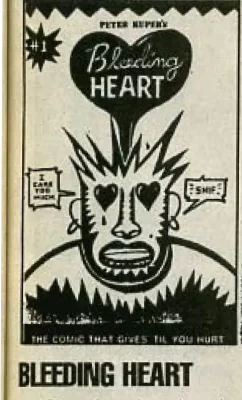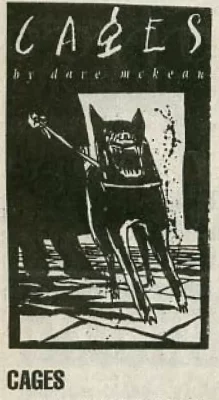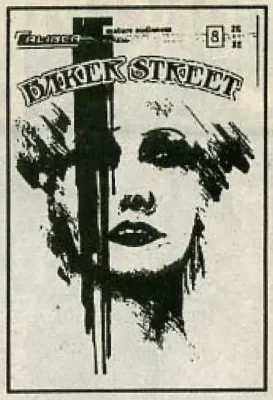Comics: February 1992
Comic
 Bleeding Heart
Bleeding Heart
Peter Kuper is perhaps best known for his humanistic cartoons in magazine like World War 3 Illustrated and Heavy Metal. Thankfully, Fantagraphics is finally providing Kuper his own forum with Bleeding Heart.
The first issue features some material previously published in the aforementioned magazines but it is deserving of reprinting. Whether tapping into his own subconscious (“Dreams of Reason”), exploring his own racism (“Color Blind”), or depicting a trip to Africa (“Gorillas”), Kuper shows a knock for honesty and thoughtfulness.
Kuper’s very stylized vision may put-off comics readers who are used to realistic but inflated art typical of superhero comics, but the drawings are powerful and evocative. Kuper’s humans are small, large, ugly, handsome—in other words, very realistic cartoons. The depictions work perfectly with Kuper’s very deliberate and revealing ramblings.
But what sets Kuper apart from many cartoonist is his ability to find something interesting and important in normal events.
The highlight of the issue is the previously mentioned “Gorillas,” a tale of Kuper and his wife’s trip to Rwanda to see mountain gorillas close-up. The story focuses more on the Kupers’ trials in trying to reach their destination, almost more than on the breath-taking simians, though. The fact that Kuper makes details such as sickness on a train trip compelling is testament to his skill. Perhaps that the point, though—civilization and its obstacles make viewing one of natures’ great animals a pilgrimage.
Impatient and immature readers will probably sneer at Kuper and his sentiments, especially with the mock “Stormin’ Norman” ad included. But, at least for now, it’s nice to see an effort being made to expand the comic book genre. Bleeding Heart should be recommended for bleedings hearts everywhere. (B&W $2.50)

Cages
Dave McKean first appeared on the comics scene as illustrator for much-hyped writer Neil Gaiman’s tales. Recently, though, McKean has moved on to his first solo project, Cages, and what an effort it is.
Envisioned as a ten-issue limited series, Cages follows the lives of people in a tenement building in a nameless city. These stories are interwoven into a solid work that calls into question all the great mysteries of life.
#4, the newest issue, features Mrs. Featherskill and her rambling narrative to her pet cockatoo as she waits for Bill to come home and looks for her ratatouille recipe. While a tragic story, McKean presents her misery so charmingly that the result is a pleasurably trip through one person’s psyche. Most surprisingly, the issue ends with sort of a punchline that is nothing short of delightful.
Those who have seen McKean previous work may be surprised at the depth and different techniques he employs. Fans of his painted work may at first be put off-by the more simplistic art, but the power of the more representational and bold drawings is astounding. In particular, the facial expressions are so vivid as to be breathtaking.
Even more incredible is McKean’s writing, however, especially when one considers this is his first published narrative. The skill involved with the natural and realistic dialogue, combined with the difficulty in weaving together disparate tales is considerable and yet this is accomplished remarkably well.
It may appear this reviewer is gushing, but the excitement of finding a comic book that dares to go beyond mere puerile superheroics and concentrate on the normal struggles of life is understandable. If all of humanity is, in fact, in cages, then tales like these may help us explore our boundaries. (color/b&w, $3.95)
 Baker Street
Baker Street
What if Sherlock Holmes and Dr. Watson had been women? Further, what if these women lived in a modern England in which Victorian society still existed? And just suppose the setting for the ensuing mysteries is in the punk underground?
All these questions and more are answered by Baker Street. This preposterous sounding series is the product of creators Guy Davis and Gary Reed although Davis, however, has taken over the writing and art. Surprisingly, while the idea may sound ludicrous, the results are pleasing and engaging.
“Holmes” in this case is Sharon (or “Harlequin”), a former police office axed for drug use, now involved in the “scene.” Playing Watson to her is Susan, an American student. Similarly there are counterparts to other “Holmes” characters including Sharon’s “Moriarty,” Mordecai James.
But, all of this effort would be for naught if the parallels were not backs by solid stories. #9, the latest chapter in the “Children of the Night” storyline, features the discovery of the identity of a “Ripper” who is preying on males.
All of this material is lent a charm that thanks to the skill of Davis. Like classical “Holmes” material, Baker Street’s mysteries aren’t really “whodunnits,” but rather presents compelling puzzles, backed by solid characterizations. Frankly, it’s about time the punk scene saw a compassionate representation in the mass media.
Best of all is Davis’ art, though. His humans aren’t all pretty, but they are human. In addition, Davis captures a Gothic feel very well with texture, shading, and foggy scenes. Little details, such as postulations on air travel and world politics help lend authenticity to the vision.
This may still sound ridiculous, but I’d advise picking up an issue or two before you scoff. You may just find that even some strange-sounding ideas have merit if presented properly. (b&w $2.50)
For more from the SLUG Archives:
Notes From The Industrial Underground: January 1992
Books and Literature: February 1992

